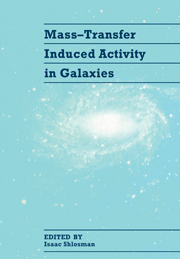Book contents
- Frontmatter
- Contents
- Preface
- List of Participants
- I INTRODUCTION
- II THE INNER PARSEC
- III THE CIRCUMNUCLEAR REGION
- IV GAS DYNAMICS AND STAR FORMATION IN BARRED AND NORMAL GALAXIES
- V NUCLEAR GAS AND LARGE-SCALE PROPERTIES OF AGN AND STARBURST HOSTS
- VI HOST GALAXY-AGN-NUCLEAR STARBURST CONNECTION
- Starbursts, Quasars, and their Environments (Invited paper) 234
- Nuclear Fueling in Two-Component Star-Gas Disks (Invited paper) 251
- Radio Loud Far-Infrared Galaxies 263
- Massive Central Black Holes as Generators of Chaos and Drivers of Large-Scale Dynamics
- Self-Gravitating Gas Dynamics: Growing Monsters and Fueling Starburstsin Disk Galaxies
- Radial Inflows in Disk Galaxies: Effects of Star Formation 279
- Self-Gravitating Gas Dynamics in a Galactic Central Region
- Nuclear Inflow under the Action of Instabilities
- Mid-IR Imaging of Interacting and Non-Interacting AGNs (Poster paper)
- Imaging of MBG Starbursts: Preliminary Results (Poster paper)
- Compact Extranuclear Structures of Mkn 298 (Poster paper)
- NGC 6814: a Very Normal Looking AGN Host Galaxy (Poster paper)
- ROSAT PSPC Observations of NGC 3079 (Poster paper)
- MK 231: AGN vs. Starburst? Steps Toward a Model (Poster paper)
- Extended Starburst Activity Induced by the Central AGN: a Model for NGC 1068 (Poster paper)
- NGC 2782, NGC 4102 and NGC 6764: Evidence for Starburst-Driven Winds
- AGN Winds and Nuclear Starbursts (Poster paper)
- VII GALAXY INTERACTIONS AND INDUCED ACTIVITY
- VIII GAS DYNAMICS IN ELLIPTICALS
- IX AGN AND STARBURST HOSTS AT LARGE REDSHIFTS
- X CONFERENCE SUMMARY
- Subject Index
- Object Index
- Author Index
Self-Gravitating Gas Dynamics: Growing Monsters and Fueling Starburstsin Disk Galaxies
Published online by Cambridge University Press: 05 May 2010
- Frontmatter
- Contents
- Preface
- List of Participants
- I INTRODUCTION
- II THE INNER PARSEC
- III THE CIRCUMNUCLEAR REGION
- IV GAS DYNAMICS AND STAR FORMATION IN BARRED AND NORMAL GALAXIES
- V NUCLEAR GAS AND LARGE-SCALE PROPERTIES OF AGN AND STARBURST HOSTS
- VI HOST GALAXY-AGN-NUCLEAR STARBURST CONNECTION
- Starbursts, Quasars, and their Environments (Invited paper) 234
- Nuclear Fueling in Two-Component Star-Gas Disks (Invited paper) 251
- Radio Loud Far-Infrared Galaxies 263
- Massive Central Black Holes as Generators of Chaos and Drivers of Large-Scale Dynamics
- Self-Gravitating Gas Dynamics: Growing Monsters and Fueling Starburstsin Disk Galaxies
- Radial Inflows in Disk Galaxies: Effects of Star Formation 279
- Self-Gravitating Gas Dynamics in a Galactic Central Region
- Nuclear Inflow under the Action of Instabilities
- Mid-IR Imaging of Interacting and Non-Interacting AGNs (Poster paper)
- Imaging of MBG Starbursts: Preliminary Results (Poster paper)
- Compact Extranuclear Structures of Mkn 298 (Poster paper)
- NGC 6814: a Very Normal Looking AGN Host Galaxy (Poster paper)
- ROSAT PSPC Observations of NGC 3079 (Poster paper)
- MK 231: AGN vs. Starburst? Steps Toward a Model (Poster paper)
- Extended Starburst Activity Induced by the Central AGN: a Model for NGC 1068 (Poster paper)
- NGC 2782, NGC 4102 and NGC 6764: Evidence for Starburst-Driven Winds
- AGN Winds and Nuclear Starbursts (Poster paper)
- VII GALAXY INTERACTIONS AND INDUCED ACTIVITY
- VIII GAS DYNAMICS IN ELLIPTICALS
- IX AGN AND STARBURST HOSTS AT LARGE REDSHIFTS
- X CONFERENCE SUMMARY
- Subject Index
- Object Index
- Author Index
Summary
ABSTRACT
The evolution of the gas distribution in a globally unstable galactic disk embedded in a ‘live’ halo is studied numerically on scales ∼ 100 pc –10 kpc. The gas and stars are evolved using a 3D hybrid SPH/N-body code and gravitational interactions are fully accounted for. The gas is assumed to obey the isothermal equation of state with T – 104 K. The effect of a massive object at the disk center is simulated by placing a ‘seed’ black hole (BH) of 5 x 107 M⊙ with an ‘accretion’ radius of 20 pc. Modifications introduced by star formation in the disk are discussed elsewhere (Heller and Shlosman, these proceedings).
We find that the global stability of a stellar disk can be heavily affected by the gas, given that the gas mass fraction fg is high enough and the gas is dissipative. We also find that the rate of radial inflow in disk galaxies is a robust function of global parameters: the inflow is bar-driven for small fg and dynamical friction-driven for largefg. Without star formation the radial inflows lead to (1) domination of the central kpc by a few massive clouds that evolve into a single object via a cloud binary system; and (2) sporadic accretion onto the BH.
- Type
- Chapter
- Information
- Mass-Transfer Induced Activity in Galaxies , pp. 274 - 278Publisher: Cambridge University PressPrint publication year: 1994
- 1
- Cited by

